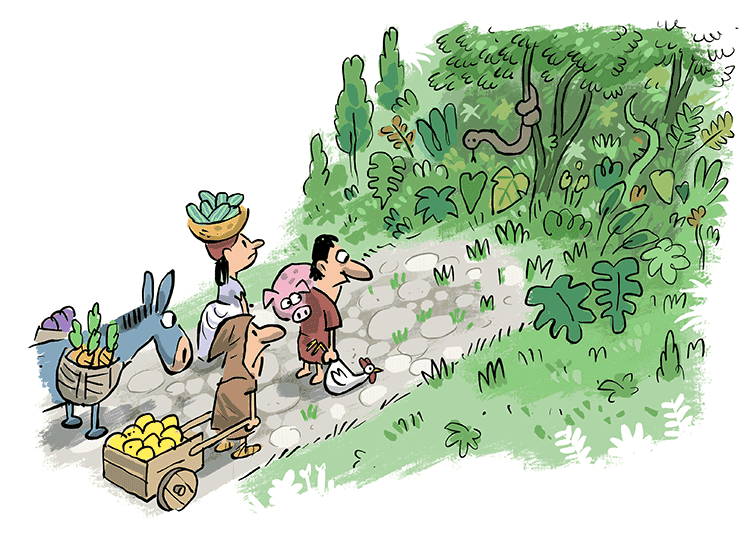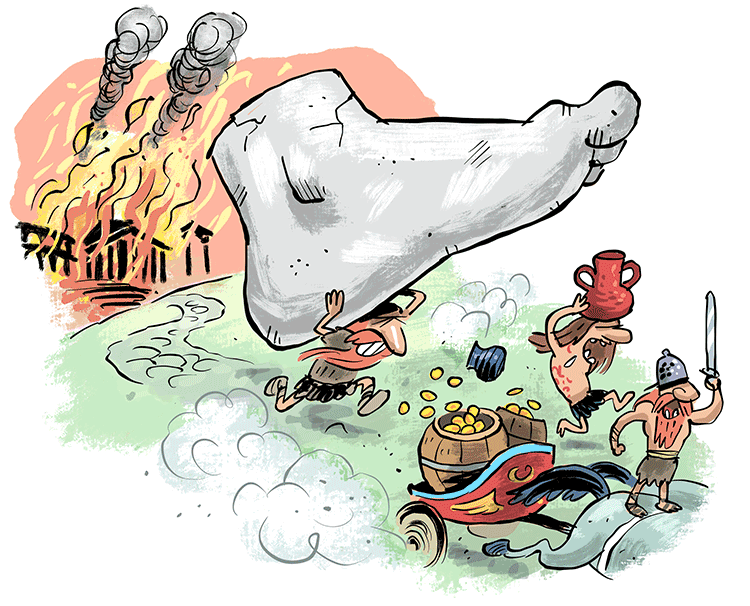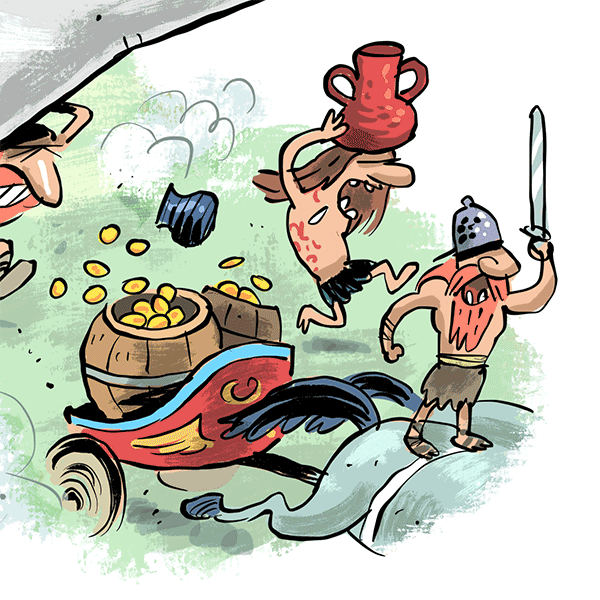Starting in the 3rd century BC (200 – 300), the city of Rome became the center of the western world. For the next 600 years, Rome’s power bloomed across Europe and western Asia, transforming human civilization and ushering in a new era of history.
But just like a good movie only lasts two hours, the glory days of the Roman Empire also had to come to an end.
Looking back in history, it’s easy to see how Rome eventually fell. But to the people living at the time, such a thing was unthinkable. So, when it finally happened, when the final Western Roman emperor, Romulus Augustus, gave up the throne, pretty much everyone turned to each other and asked: now what?
The “Fall” of Rome
Although 476 AD is used as the official date of the fall of the Roman empire, this is a bit misleading.
For one, it refers specifically to the fall of the Western Roman empire. Starting in the early 4th century, the Roman empire had been divided into eastern and western parts to help make it easier to manage.
The decision to do this was partly made in response to the growing prosperity in the east. There were more people and more resources in the lands of modern-Turkey, Greece, Syria, and Palestine, for the Romans to really care all that much about their western provinces.
Plus, there was always someone trying to invade Western Europe, making it a real pain to defend, not to mention an expensive one.
So, in the final century of the Roman Empire, its leaders pretty much left the West for dead. But this meant that when the West did fall, the East could continue on, which it did for another 1,000 years.
Today, we call the empire who lived Byzantium, named after the original name of its capital city, Byzantine. However, to the people at the time, Byzantium was still the Roman Empire, and the people living within its boundaries still called themselves Roman.
So, in this sense, the idea that Rome “fell”in 476 AD isn’t really true. It continued on, just in a totally different way.
Western Europe’s Economic Collapse
One of the biggest impacts of the fall of Rome and the Western Roman Empire was that the economy of western Europe essentially collapsed.
This was not an overnight thing, though. The economy had been stressed for some time, and things only got worse when Rome was sacked and officially conquered.
At the center of western Europe’s economic problems at the time were degrading infrastructure, high taxes, and repeated invasions from Germanic tribes.

Roman Roads Fall into Disrepair
The Roman empire was so successful at uniting people and encouraging prosperity largely because of roads.
Ever hear the expression “all roads lead to Rome”? Well, it comes from, you guessed it, the Roman system of roads.
The Romans built an extensive network of roads all across Europe and into western Asia, all with the intention of making it easier for people and goods to move around. Oh, and also to let its armies travel more quickly and conquer new lands more easily. Can’t forget that of course.
Roads are wonderful, sure. But they cost money to maintain. And as Rome expanded, its expenses grew. It needed to maintain a larger army, build new cities, fight new wars, and much more, all of which depleted the imperial bank accounts.
One of the things often left to the wayside was road maintenance. Western Europe, which by the later parts of Roman history were considered less prosperous and therefore less important, caught the brunt of this neglect.
Therefore, when Rome finally fell, it simply made a bad situation worse, and trade all but ended. The quality of goods found in western Europe dropped significantly, people had a harder time finding buyers for their goods, and people became increasingly desperate.
Higher Taxes
To add insult to injury, the Romans had to keep raising taxes on citizens of its empire to help pay for its failing state.
Most people don’t mind paying more when they’re getting something in return. But when they’re paying more and getting less, well, that doesn’t usually sit too well.
Raising taxes decreased the legitimacy of Roman rule in western Europe. People started looking towards other leaders, and watchful eyes from beyond the empire’s frontiers saw this as an opportunity.

Invasions from Germanic Tribes
Outside of the Roman empire, life still existed (believe it or not). In the immediate areas surrounding the Roman provinces in western Europe, Germanic tribes dominated. These people spoke some version of a Germanic language, though there were many variations under the Germanic label.
To the Romans, they were all barbarians, the term used for non-Roman people of any kind.
Seeing Rome’s grip on power weaken, these “barbarians” began invading, hoping to take some of Rome’s prized territory for their own.
Remember how the Roman emperors pretty much turned their backs on the west? Well, this left the people in western Europe to fend for themselves, and opened the doors for all sorts of invaders.
The result: chaos.
Complete and total chaos.
The invasions of these tribes not only added to the political instability of the region, but they also made life downright miserable. It was not uncommon for them to rage into a city, loot it for all its valuables, kill whoever stood in their way, and then burn it to the ground.
Such attacks weren’t good for morale, for the economy, or anyone, really. They all but destroyed the foundation of Roman rule in western Europe.
A Rush to the Countryside
One impact that all of this had on life in western Europe was that people started leaving the cities that had been built by the Romans.
Once great places to live, where jobs could always be found and one could enjoy amenities such as running water and protection from raiding hoards of vandals, cities became less desirable when they stopped receiving support from the city of Rome and its empire.
Cities were also the main targets of raiding “barbarians,” and they were quickly falling into disarray. This caused people to leave the cities and move to the countryside. This may have been freeing at the time, but rural life comes with its own set of consequences.

The Foundation of Feudalism
All of this upheaval in western Europe helped usher in the age of feudalism. Feudalism is a political and economic system in which nobles, who pledge loyalty to a monarch, control all the land. The people who work the land are tied to their noble. They are allowed to work on the land but they must give a certain amount of what they produce to their noble as a tax. They may also be called upon to fight wars for their noble, aka lord, if necessary.
It was a pretty bad deal for the workers. And a really good one for the nobles. No one ever said life was fair.
But in exchange, they would receive protection from the lord, mainly from barbarians but also from the armies of other lords who got too ambitious. This proved to be pretty important, so the people went along with this horribly unequal system.
Also, because Rome was gone, they pretty much had no other choice.
Much of medieval political and military history is based on the ongoing conflicts and coalitions between different nobles and their allies, and the reason this context was able to emerge was the fall of the western Roman empire and the powerful centralized authority of Rome.
Christianity Takes a New Role
Another major impact of the fall of the western Roman Empire that went on to shape the Middle Ages was the changing role of Christianity.
Once persecuted in the Roman Empire, Christianity became tolerated starting in the 4th century and then became the official religion of the empire.
Then, when Rome fell, people in Western Europe turned to the Church as an authority. No one else was in charge, so why not trust God?
The combination of its religious popularity and its connection to the Rome of old made the Church an attractive institution, and its leaders had no problem going along with this.
The Pope, the leader of the Roman Catholic Church, became an increasingly influential figure in the western world and began to exert his power in other parts of Europe and Asia.
Eventually, the Church would rise to be the unifying power in the western world. It had an impact on nearly every aspect of life, an influence that continues until this day.
Did Rome Ever Fall?
The city of Rome fell, its political apparatus in western Europe fell, but its influence, in some form or another, continued on, even after it was no longer an empire.
Western Europe underwent a significant transition after the fateful year 476 AD, but it was a transition very much shaped by the decline of Rome and its eventual demise.
So although the city fell into the hands of invaders, and the Western Roman Empire broke into pieces, it’s still worth asking: did Rome ever really fall?
Written by Matthew Jones
Illustrated by Jean Galvao
